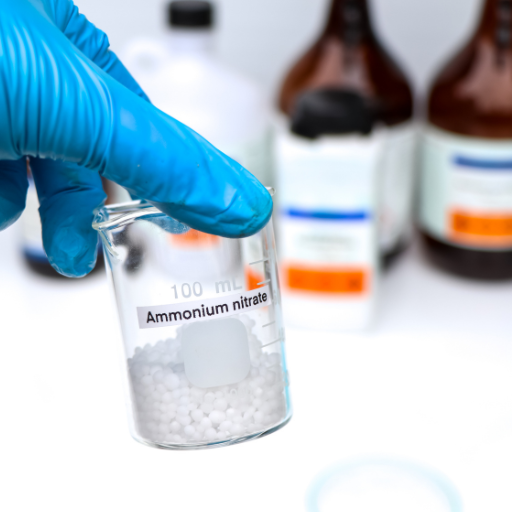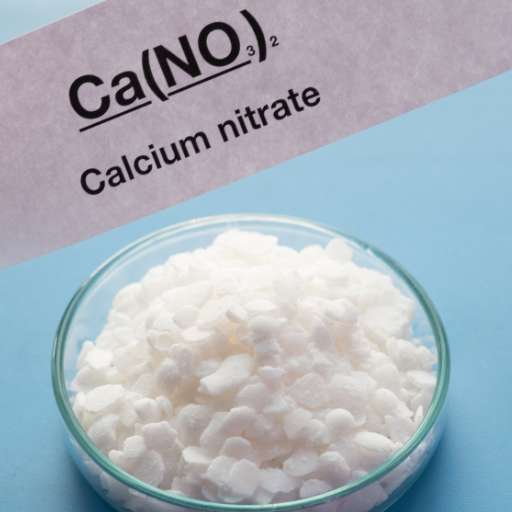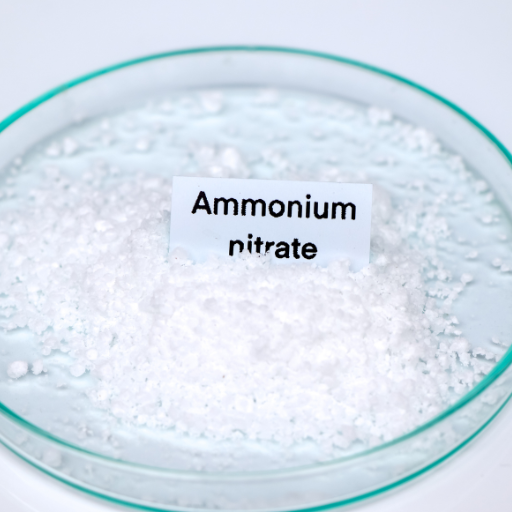Modern agriculture depends on ammonium nitrate fertilizer which is important in providing vital nutrients that help crops grow well and become strong. This blog seeks to uncover the beginnings of ammonium nitrate, showcasing the full process from raw materials to final product that feeds the world. Comprehending how it is produced, where its primary constituents come from, and how it has developed historically will give a general view of why ammonium nitrate is essential in today’s farming methods. Consequently, this paper examines these aspects in order to enhance readers’ understanding about the importance of this essential fertilizer and its implications on food security worldwide.
What is Ammonium Nitrate Fertilizer?

Perennial fertilizer of the ammonium nitrate family, a chemical compound used mostly in farming to increase crop production. Nitrogenous is contained in it, an essential molecule for plants to grow that makes it outstanding among other nitrogenous fertilizers with regards to its high nitrogen content and ready solubility in water for immediate availability as plant need it. The ammonia in ammonium nitrate converts to nitrates which are then used in making proteins that are important during plant synthesis and development hence improvement of crops. It is therefore effectively efficient, user friendly and dependable thus forming a pillar in modern agricultural practices.
How is Ammonium Nitrate Composed Chemically?
Ammonium nitrate (NH₄NO₃) consists of ammonium (NH₄⁺) and nitrate (NO₃⁻) ions. The formula suggests that each molecule has one nitrogen atom attached with four hydrogen atoms (to form an ammonium ion) and another nitrogen atom attached three oxygen atoms (to form a nitrate ion). This is why ammonium nitrate contains so much more than other nitrogenous fertilizers—it has 34% nitrogen by weight, making it very good at providing this nutrient to plants.
From the technical standpoint, the property that distinguishes ammonium nitrate from other substances is its ability to dissolve rapidly in water; the solubility rate at 0 degree Celsius equals 118 g/100 ml but rises as temperature increases. After application, the nitrogen becomes almost immediately available for plants since this substance dissolves quickly into water dissociating into NH4+ and NO3- ions. Moreover, it can promptly release nitrates ions through hydrolysis thereby facilitating uptake by plants thereby accelerating their growth too.
What Role Does Ammonium Nitrate Play as Fertilizer?
Ammonium Nitrate works as manure by giving plants available forms of nitrogen needed for proper growth and development. Following the application of this substance into soil water, it dissolves readily forming ammonium ions (NH₄⁺) and nitrate ions (NO₃⁻). Consequently, these are taken up by plant roots using specific ion channels across their membranes. Nitrate ions on the other hand are directly involved in amino acids synthesis that is a prerequisite for protein production required in activities of all cells within the plant body. Additionally, ammonium ions can be assimilated or converted by soil bacteria into nitrates thereby making nitrogen available to plants over longer periods.
Technical grounds for justifying the efficiency of ammonium nitrate as a fertilizer involve:
- Nitrogen Content: About 34% Nitrogen per weight.
- Water Solubility: Dissolves at 118 g/100 mL at 0°C and goes up with temperature that can make the dissolution process take place faster than usual.
- Dissociation Rate: Rapidly decomposes to NO3– and NH4+ in contact with water for immediate absorption by plants.
These attributes enable ammonium nitrate to serve as an efficient and dependable source of nitrogen, thus supporting stronger growth of crops and better farming outcomes.
Benefits of Using Ammonium Nitrate in Agriculture
Ammonium nitrate has several benefits to its use in agriculture. First, the high nitrogen content of approximately 34% by weight ensures that plants receive a considerable amount of this necessary nutrient. The increasing concentration of such high concentration results in more effective and efficient fertilization which leads to better plant growth. Second, the compound’s good solubility in water i.e. it dissolves 118 g per 100 mL at 0°C with increase in temperature makes it readily available for uptake by plants shortly after applying it. This quick dissolution provides immediate benefits to crops thereby helping them grow quickly.
Additionally, when ammonium nitrate comes into contact with water, its rapid dissociation rate into NH₄⁺ and NO₃⁻ ions allows for quick absorption by plant roots. While nitrate ions are directly used to make crucial proteins and amino acids, soil microorganisms either assimilate ammonium ions or change them into nitrates. This double availability mode of nitrogen sustains nutrient supply to plants thus supporting continuous growth stages.
The aforementioned technical parameters (high nitrogen content, great solubility and fast dissociation) all make ammonium nitrate as an effective fertilizer reasonable. These characteristics contribute towards healthier plants and probably increased agricultural yields hence support enhanced production values of farming operations at large
How is Ammonium Nitrate Produced?
In order to produce ammonium nitrate from nitric acid and ammonia, concentrated nitric acid (HNO₃) is mixed with anhydrous ammonia (NH₃). This reaction occurs in a neutralization reactor which results in ammonium nitrate (NH₄NO₃) and water. The reaction is highly exothermic, releasing large amounts of heat that must be managed for safety and reaction efficiency. Afterward, the resultant solution of ammonium nitrate solutions is subjected to several evaporation steps during which the excess water is removed. Subsequently, solid ammonium nitrate crystals are obtained through crystallization of the concentrated solution. The final product can also be coated so as to prevent clotting or caking as well as improve flowability when being used as a fertilizer. Such production process has strict control measures aimed at ensuring the purity and consistency of the fertilizers’ active ingredient – NH4NO3.
Ammonia’s Role in Ammonium Nitrate Production
Ammonia plays an important role in the synthesis of ammonium nitrate by acting as the main reagent that combines with HNO_3. NH_3 provides nitrogen constituent necessary for creating NH_4NO_3. When this happens, highly pure solution of NH4NO3 and water is formed due to a combination between concentrated HNO_3and anhydrous ammonia that results into an exothermic reaction; thus making it possible for large production scale while maintaining quality control mechanisms throughout this process chain. These include: proportioning precision during addition of ingredients such as dinitrogen pentoxide, maintained pH level around 8-9 among other factors on temperature, time etc., scrupulous adherence towards right sequence phasing operations starting from nitrating liquid (a mixture containing 68% H2SO4 by mass) to obtain ammonium nitrate crystals at desired sizes; evaporation of excess H2O until saturation point which is required before starting cooling stage. Moreover, the production process relies on this important reactant as opposed to any other one for nitrogen-rich reaction mixture that is much useful in agricultural practices.
Manufacturing Ammonium Nitrate from Nitric Acid and Ammonia
The production of ammonium nitrate from nitric acid and ammonia begins with the addition of anhydrous ammonia (NH₃) to concentrated nitric acid (HNO₃). This neutralization reactor produces water and ammonium nitrate (NH₄NO₃). In this phase, there is huge heat amount released since it is very exothermic hence proper safety precautions are vital. The resulting ammonium nitrate solutions are usually dried through evaporation series until all free water has been removed. This solution then undergoes crystallization where the solid NH4NO3 is formed. Finally, the pellets or granules are coated with certain substances such as anti-caking agents so that they do not get sticky together but rather run smoothly when poured out like grains of fertilizer.
Steps in the Production of Ammonium Nitrate
- Introduction of Anhydrous Ammonia to Concentrated Nitric Acid
-
- Process: Begin by introducing anhydrous ammonia (NH₃) to concentrated nitric acid (HNO₃) in a neutralization reactor.
- Reaction: NH₃ (g) + HNO₃ (aq) → NH₄NO₃ (aq)
- Output: Ammonium nitrate and water mixture.
- Considerations: The reaction is highly exothermic, releasing considerable heat which must be managed to ensure safety and reaction efficiency.
- Evaporation Stages to Concentrate Ammonium Nitrate Solution
-
- Process: The ammonium nitrate solution from the neutralization reactor is subjected to evaporation stages.
- Objective: Remove excess water from the solution to increase ammonium nitrate concentration.
- Data: Typically, concentrations are increased to approximately 83-95% for further processing.
- Crystallization of Concentrated Solution
-
- Process: The concentrated ammonium nitrate solution is cooled and subjected to crystallization.
- Technique: Employing vacuum crystallizers for precise temperature control and crystal formation.
- Outcome: Formation of solid ammonium nitrate crystals from the solution.
- Drying of Ammonium Nitrate Crystals
-
- Process: The formed ammonium nitrate crystals are then dried to remove any residual moisture.
- Method: Utilize rotary or fluidized bed dryers.
- Parameters: Ensure moisture content is reduced to less than 0.2% to prevent caking and enhance stability.
- Cooling of Dried Ammonium Nitrate
-
- Process: The dried ammonium nitrate is cooled to ambient temperatures.
- Equipment: Use cooling drums or fluid bed coolers.
- Purpose: Prevents thermal degradation and prepares the product for further handling.
- Prilling/Granulation for Desired Particle Size
-
- Process: Ammonium nitrate is either prilled or granulated depending on the desired particle characteristics.
- Prilling: Produces small, spherical particles using prill towers.
- Granulation: Involves compounding and milling to generate larger granules.
- Application of Anti-Caking Agents
-
- Process: Coating the ammonium nitrate with anti-caking agents.
- Agents: Common agents include clay, oil, or polymer additives.
- Purpose: To maintain free-flowing properties during storage and handling.
The outlined steps ensure the efficient and safe production of high-quality ammonium nitrate suitable for various agricultural applications. Each stage is carefully controlled to maximize yield and meet stringent industrial standards.
Where Do the Raw Materials Come From?

Ammonium nitrate is made from ammonia and nitric acid. Ammonia is created using the Haber-Bosch process, where hydrogen from natural gas combines with nitrogen in the air. Nitric acid is produced through the Ostwald process which involves oxidation of ammonia to nitric oxide, then further converting it to nitrogen dioxide and finally to nitric acid by absorption in water. These raw materials are then reacted together to produce ammonium nitrate that can be manufactured into various forms for use in agriculture and industry.
Ammonia Sourcing: Natural Gas and Others
The dominant source of hydrogen for ammonia production is natural gas due to its efficiency and cost-effectiveness. Steam methane reforming (SMR) produces hydrogen by reacting high-temperature steam with natural gas. Other means of sourcing ammonia include electrolysis of water, which uses electricity to split water into oxygen and hydrogen, as well as biomass feedstocks providing a renewable source of hydrogen for ammonia synthesis. These alternate methods broaden the production base beyond reliance on natural gas while minimizing environmental effects.
An Overview on Nitric Acid Production
Mostly, the manufacturing process for nitric acid follows Ostwald process characterized by catalytic oxidation of ammonia. Initially, using a platinum-rhodium catalyst at high temperatures ammonia oxidizes into nitrogen monoxide (NO). The latter is further oxidized into nitrogen dioxide (NO2). Eventually, NO2 absorbs in water forming HNO3 . For this industrial process to be efficient overall, it must maintain suitable temperatures and pressures as well as maximize conversion rates using effective catalysts. By employing multiple absorption towers with recycling unreacted gases, modern facilities achieve high purity and concentration making it more environmentally friendly and cost-effective.
Environmental Costs of Material Extraction
There are significant environmental consequences associated with extraction of raw materials used in industrial processes. Mining activities related to obtaining natural gas that serves as a precursor for ammonia production result into habitat destruction, groundwater pollution and release of methane into the atmosphere. Natural gas utilization also contributes to greenhouse gas emissions thereby making climate change more severe. Conversely, electrolysis of water for hydrogen production although energy intensive, can be environmentally friendlier if it relies on renewable sources. Biomass feedstocks offer a renewable alternative but require extensive land use that may result in deforestation and loss of biodiversity if not managed properly. These include improving extraction technologies, enforcing stricter environmental regulations, and transitioning to more sustainable raw material sources in order to reduce these impacts.
What are the Uses of Ammonium Nitrate?

Its high nitrogen content is the main reason that ammonium nitrate is used so much in agriculture as a fertilizer. It does this better than any other fertiliser, because it provides nitrates and ammonia – both of which are forms of nitrogen. Ammonium nitrate is also a key component in the manufacture of explosives mainly for use in mining and construction for its highly oxidizing property. It is not only considered applicable for wastewater treatment but also has exothermic properties when mixed with water to become one of the components that make up cold packs utilized in medicine.
Ammonium Nitrate in Agriculture
Ammonia nitrate is highly sought after by farmers because its fertilizers contain high levels of nitrogen needed to increase crop yields. Having about 34% nitrogen, this compound becomes an ideal source of nutrients required by plants. Ammonium nitrate, when applied on soil, yields nitrous form (NO3-) and ammonium form (NH4+), such forms can be readily absorbed by plants. This double form thus ensure maximum availability of nitrogen and promote growth of healthy plants. The technical parameters according to which ammonium nitrate functions prove its effectiveness as a fertilizer: it has high solubility hence allowing accurate nutrient dosing minimizing loss and contamination from leaching into underground waters due to excessive amounts; good farming practices help maximise profits while improving environmental conditions.
The Explosive Nature of Ammonium Nitrate
The explosive nature of ammonium nitrates comes from the fact that it acts as an oxidant for most situations involving combustion or explosion hazard materials like fuels. When mixed with an appropriate fuel, it can cause a very strong explosion.. To manufacture explosives used in mining, construction and demolition industries, at least one major component often used is Ammonia Nitrate Fuel Oil (ANFO). Due to its effectiveness particularly under controlled circumstances and stability in such conditions, ANFO (Ammonium Nitrate Fuel Oil) is a commonly used formulation which makes it suitable for mining activities, quarrying as well as construction.
Industrial Applications of Ammonium Nitrate
Its oxidant property makes ammonium nitrate an essential constituent in different industrial applications. This compound is widely applied in the production of fertilisers because of its high nitrogen content that promotes plant development and enhances agricultural productivity. In addition to this, it is also used extensively in the explosives industry. One common example of a widely used formulation is ANFO (Ammonium Nitrate Fuel Oil) which has proved to be effective and relatively stable under controlled conditions, hence its use in mining, quarrying and construction activities.
As far as technical parameters are concerned, ammonium nitrate has a high degree of solubility that allows precise nutrient application in agriculture with minimal environmental consequences. The oxidizing properties of ANFO are responsible for its explosive capabilities thus creating balanced energy release when detonated. However, care must be taken due to the fact that it can easily react badly if exposed to heat or shock thereby causing unforeseen explosion incidents.
Why is Ammonium Nitrate Controversial?

Ammonium nitrate is a very controversial substance due to its duality as a valuable industrial chemical as well as an explosive that can cause great harm. It is commonly found in fertilizers and explosives making it an everyday material used in industries, though the numerous catastrophic events caused by its explosive characteristic have been reported. Outbursts of these kinds caused by high profile accidents like Beirut explosion of 2020 and other industrial disasters have demonstrated how dangerous it is when handled negligently. Terror attacks involving ammonium nitrate necessitate tighter security and stricter storage measures since they are accessible. As a result, whether the benefits provided by ammonium nitrate as an industrial product outweigh the associated risks remains a subject for debate.
Case Studies of Ammonium Nitrate Explosions
The Beirut explosion of 2020 serves as a vivid example of the deadly power this compound possesses. Inadequately kept in a warehouse approximately 2,750 tonnes of chemical substance blew up causing destruction all over with more than two hundred people died and thousands others were injured. The enormity of that blast put emphasis on the need for strict regulation and oversight regarding proper storage facilities.
Another significant incident happened at West, Texas in 2013 where fifteen people died while hundreds others were wounded following an explosion after fire consumed a fertilizer plant. This highlighted poor storage practices and lack of safety protocols needed to prevent such tragedies hence there should be better regulatory frameworks.
A case in point is the Texas City disaster which occurred in 1947 whereby about six hundred people perished after a ship carrying more than two thousand tons of ammonium nitrates caught fire and exploded. Being among the most devastating industrial mishaps ever recorded within America’s history has depicted what happens if ammonium nitroprusside is not properly managed.
Regulatory Challenges and Solutions
There are major challenges for regulators, who must reconcile such issues with industry precedence over public safety . First, most major accidents have been the result of poor storage and handling protocols. Thus, storage policies need to be in place that stipulate safe distances from populated areas and require the use of fire retardant materials when constructing warehouses.
Another problem is that ammonium nitrate is readily accessible to those with ill intentions. To address this, there should be stringent licensing procedures and tracking systems so that only verified entities can gain access while transactions and movements are also recorded.
On an international scale, these regulations differ widely; therefore harmonizing these standards would facilitate a more unified approach to the safe handling and storage of ammonium nitrate. It will improve safety standards globally if best practices, research findings as well as technological advancements are shared cooperatively across countries.
Lastly, regular inspections along with updated safety measures cannot be overstated. The risk of accidents can be greatly minimized through routine checks coupled with use of cutting-edge safety technologies like real-time leak detection sensors or temperature monitors. The application of sensor technology that has advanced so much over the years together with artificial intelligence (AI) which predicts and mitigates possible hazards could play a crucial role in averting future ammonium nitrate induced catastrophes.
How is Ammonium Nitrate Stored and Handled?

Ammonium nitrate should be stored in well-ventilated areas far from heat and ignition sources. It is necessary to keep it dry and in sealed containers to avoid its absorption of moisture that may lead to caking and possible instability. In addition, the storage buildings are usually made out of fire-resistant material while the amount held at a single place is limited so as to reduce any risk. For example, when handling ammonium nitrate, one must ensure that it is not contaminated with oils or organic matter that can make it become explosive.
Safe Management of Ammonium Nitrate
Implementing safe management practices for ammonium nitrate involves comprehensive risk assessments and adherence to stringent regulatory standards. Safe storage should be done in physically isolated locations surrounded by fireproof barriers. Containers must be made of non-combustible material because holes can trap heat inside them easily leading to explosion risks. Ensuring how employees handle this product safely as well as emergency response plans ought to be prepared seriously. The use of real-time monitoring systems will help detect any deviation from normalcy whereas regular safety audits may also help reduce potential hazards. Finally, sharing best practices among different stakeholders globally while strengthening safety standards would provide effective risk management.
Regulations for Storing Large Amounts of Ammonium Nitrate
Regulations for storing large amounts of ammonium nitrate are comprehensive and vary by country but generally focus on minimizing risks associated with its explosive nature. Zoning laws apply strictly where facilities need to locate their stores away from populated areas and critical infrastructure within them. On top of this, the material should therefore be kept in either fireproof buildings or containers that have ventilation adequate enough for prevention overheating effects on it since it can explode even if there isn’t any ignition source around (Bryant 2013). Generally speaking, strictness dictates detailed record-keeping including inventory management directed towards the quantities and movements of the chemical substance concerned. It is also necessary that they form a part of their emergency plan that includes coordination with local fire departments and hazardous material teams. Safety protocols should be subject to periodic inspections and audits which, if breached in any incident, warrant severe penalties and remedial measures.
Preventing Ammonium Nitrate Explosions
Preventing ammonium nitrate explosions requires a multi-faceted approach geared towards minimizing the conditions under which such incidents may occur. First of all, temperature needs to be controlled and conditions within which it is stored be managed properly. Thus, it should be kept in cool dry well-ventilated places ideally below 30°C (86°F) to minimize heat induced decomposition (Bryant 2013). Furthermore, storage of large amounts of ammonium nitrate as well as its separation from other substances that can act as fuel in case of fire should also be avoided.
In terms of technical parameters, the NFPA 400 Hazardous Materials Code specifies that storage facilities need to have a thermal monitoring system that can alert operators to any significant deviations in temperature. Moreover, however excessive concentration of ammonium nitrate should not exceed more than 80% so that explosion risks are minimized.
Regular inspections and maintenance of storage facilities are essential in preventing accidents. Such include proper electrical maintenance procedures aimed at preventing sparks and clean floors without contaminations exposing them to hazards such as fires. At the same time, explosion resistant electrical apparatuses should always been used while conducting routine risk assessments helps identify potential failures before they become disasters.
Also, being ready for emergencies is a part of prevention measures. For example, storing of ammonium nitrate in fire-proof containers and having efficient systems for fighting with fires can reduce the impact of fire accidents. Furthermore, there is an absolute necessity for training courses that are all-inclusive concerning danger detection and response in emergencies dedicated to avoidance of system failures.
Following these instructions will minimize the possibility of ammonium nitrate explosions through ongoing updates to safety practices based on the newest scientific studies and regulatory standards.
What are the environmental concerns associated with using ammonium nitrate?

Ammonium nitrate is a problematic compound in the environmental context as it relates to water pollution. Dissolution of ammonium nitrate in water leads to the increase of nitrogen levels, causing eutrophication, an overgrowth of algae which consumes oxygen and damages aquatic life. Moreover, ammonium nitrate fertilizers could be washed into drinking water as a result of runoff from agricultural lands. This can lead to excessive nitrates that are toxic to human beings and cause diseases such as cyanosis among infants. In fact, managing and applying ammonium nitrate requires careful handling so that pollution can be prevented.
Soil Health and Water Quality Impact
The use of ammonium nitrate could have negative impacts on soil health and water quality. Application of more than enough ammonium nitrate in soils may acidify them altering microbial communities thus possibly affecting plant growth . These changes occur causing soil fertility reduction long term for example if ammonium nitrate is not managed correctly then it may wash off into nearby surface waters or leach into groundwater system leading to elevated concentrations of nitrates that endanger human life resulting into conditions like methemoglobinemia that affects infants called also “Blue baby” syndrome. The most effective strategies include using proper fertiliser quantities according to soil tests hence precision farming approaches and capturing runoff before it enters streams with buffer zones.
How To Counteract Environmental Effects
To counter the adverse effects on the environment, there exist various measures including technical ones.
- Precision Agriculture: Proper application of fertilizer involves using precise amounts for each particular field; this ensures that excesses do not spill onto other areas. Precise application means fewer losses due to leaching hence reduced nutrient loads in rivers or aquifers.
- Buffer Strips and Vegetative Barriers: It is proven that planting grasses or other plants around agricultural fields can reduce run-off massively especially where buffer strips are established between fields and bodies of water; these vegetation covers function as filters which trap and safely use excess nutrients so that these do not end up in streams, rivers or lakes.
- Controlled Release Fertilizers: Using controlled-release formulations of ammonium nitrate can mitigate the risk of leaching and runoff by providing a slow, steady supply of nutrients. These releases match crop uptake rates so as to maintain soil health and water quality.
- Irrigation Management: It is crucial to modify irrigation methods in order to minimize wastage of water and reduce runoff. For example, drip irrigation directly supplies water to plant roots thereby minimizing nutrient-rich run-off and leaching into groundwater strata.
- Cover Crops: Soil erosion would be brought down significantly, while nutrient loss will be prevented if cover crops are grown during the off seasons. Plants such as clover or rye grass can absorb residual nitrogen found in soils thus improving fertility and structure for planting later on.
Technical Parameters:
- Variable Rate Technology (VRT): Ensures precise fertilizer application based on actual time soil data.
- Nitrate Concentration Limits: Nitrate levels beyond 10 mg/L in drinking water are dangerous according to safe drinking water standards
- Release Rate of Controlled-Release Fertilizers: Should align with crop nutrient uptake, typically over a growing season of 90-120 days.
By employing these techniques, the adverse environmental impacts associated with ammonium nitrate can be considerably limited leading to sustainable agriculture practices which preserve ecosystem health.
Reference sources
- Crop Nutrition
- Source Link: Where Does Ammonium Nitrate Come From?
- Summary: This source provides valuable insights into the background of ammonium nitrate as the first solid nitrogen fertilizer produced at scale, highlighting its historical significance and usage in agriculture.
- CAS Insights
- Source Link: Ammonium nitrate: making it safer today for a better tomorrow
- Summary: The article explores the modern applications of ammonium nitrate in animal farming, particularly in pasture and hay fertilization, emphasizing its importance and safety considerations in contemporary agricultural practices.
- ScienceDirect
- Source Link: Ammonium Nitrate – an overview
- Summary: This resource provides an overview of ammonium nitrate, highlighting its predominant use in agriculture as a high-nitrogen fertilizer and its additional applications in explosive mixtures in industries like mining and civil engineering.
Frequently Asked Questions (FAQs)
Q: What is ammonium nitrate fertilizer and how is it used in agriculture?
A: Ammonium nitrate fertilizer is a nitrogen-rich compound used to enhance crop growth. It provides a readily available source of nitrogen, essential for plant development and increased agricultural yield.
Q: Where does ammonium nitrate fertilizer come from?
A: Ammonium nitrate fertilizer is produced by neutralizing nitric acid with ammonia. The resulting solution of ammonium nitrate can be converted into various forms, including solid ammonium nitrate, which is often used in agriculture.
Q: How does ammonium nitrate differ from other nitrogen fertilizers like ammonium sulfate?
A: While both ammonium nitrate and ammonium sulfate provide nitrogen to plants, ammonium nitrate contains a higher concentration of nitrogen. Ammonium sulfate also supplies sulfur, another vital nutrient, which ammonium nitrate does not provide.
Q: Why is nitrogen important in fertilizers like ammonium nitrate?
A: Nitrogen is essential for plant growth and development as it is a key component of chlorophyll, amino acids, and proteins. Fertilizers like ammonium nitrate provide a concentrated source of nitrogen, promoting healthy plant growth and increased crop yields.
Q: What precautions are necessary when storing ammonium nitrate fertilizer?
A: Ammonium nitrate should be stored in a cool, dry, and well-ventilated area away from incompatible materials such as fuel oil and other combustibles. Proper storage is crucial to prevent the decomposition of ammonium nitrate and reduce the risk of accidental ignition and explosive mixtures.
Q: Can ammonium nitrate be used for purposes other than agriculture?
A: Yes, ammonium nitrate is used as an industrial explosive, particularly in mining and construction. When mixed with fuel oil, it forms a powerful explosive known as ANFO (ammonium nitrate and fuel oil), widely used in these industries.
Q: What makes ammonium nitrate potentially dangerous?
A: Ammonium nitrate can act as a high explosive under certain conditions, especially when contaminated with fuels or other combustible materials. Its ability to decompose into nitrogen and oxygen gases can lead to violent explosions if not handled and stored properly.
Q: How does ammonium nitrate compare with calcium nitrate as a fertilizer?
A: Both ammonium nitrate and calcium nitrate provide nitrogen to plants, but calcium nitrate also supplies calcium, which is beneficial for soil health and plant structure. Ammonium nitrate typically offers a higher concentration of nitrogen compared to calcium nitrate.
Q: Is it safe for small-scale farmers to use ammonium nitrate fertilizers?
A: Yes, it is generally safe as long as proper handling, storage, and application procedures are followed. Farmers should be aware of the potential risks associated with improper storage and the need to keep ammonium nitrate away from combustible materials to avoid creating explosive mixtures.
Q: How is the decomposition of ammonium nitrate managed in industrial applications?
A: In industrial settings, strict protocols are followed to monitor the temperature and chemical purity of ammonium nitrate to prevent unwanted decomposition. Specialized equipment is used to detect and control any potential hazards associated with its handling and storage.






